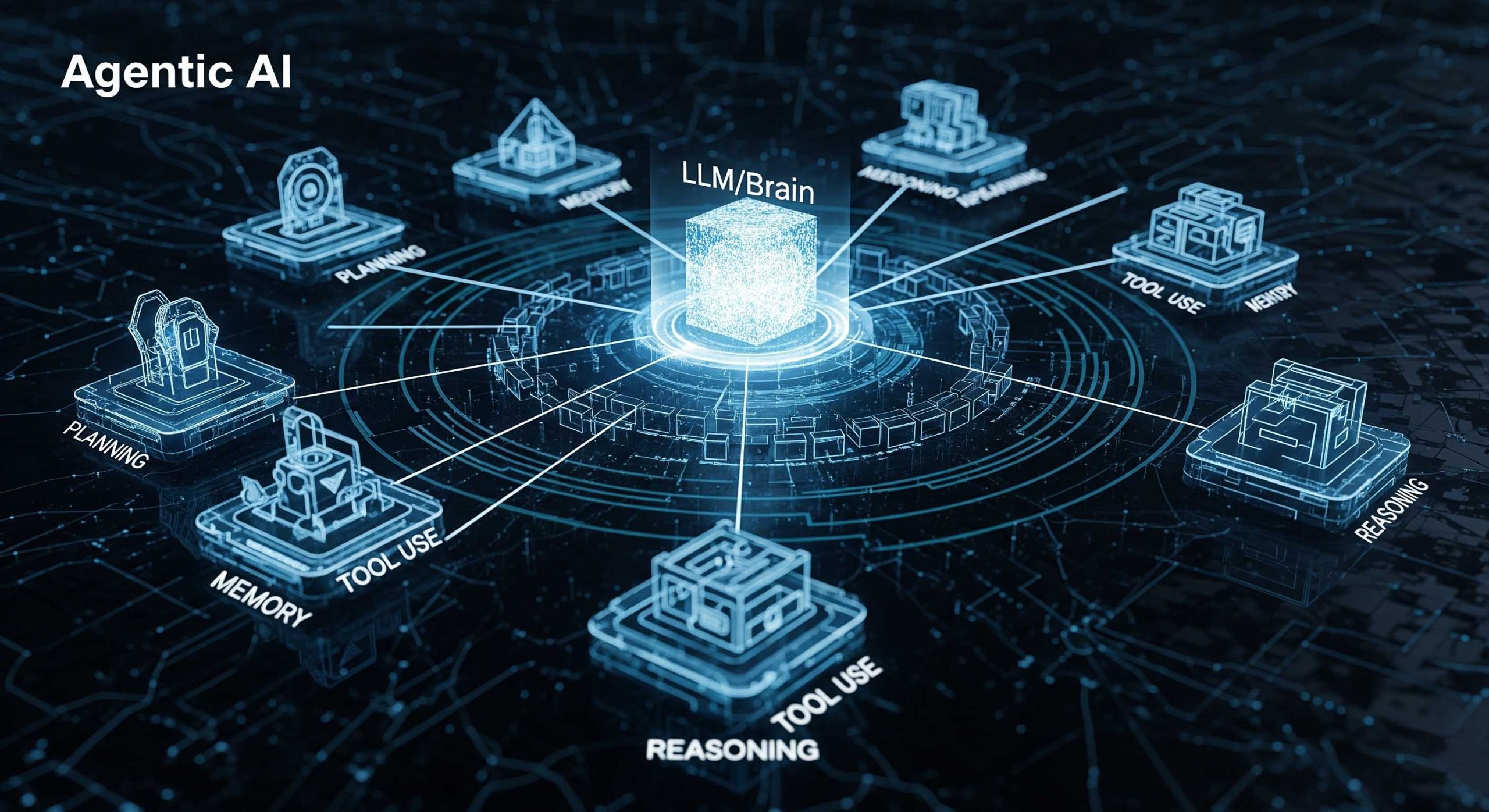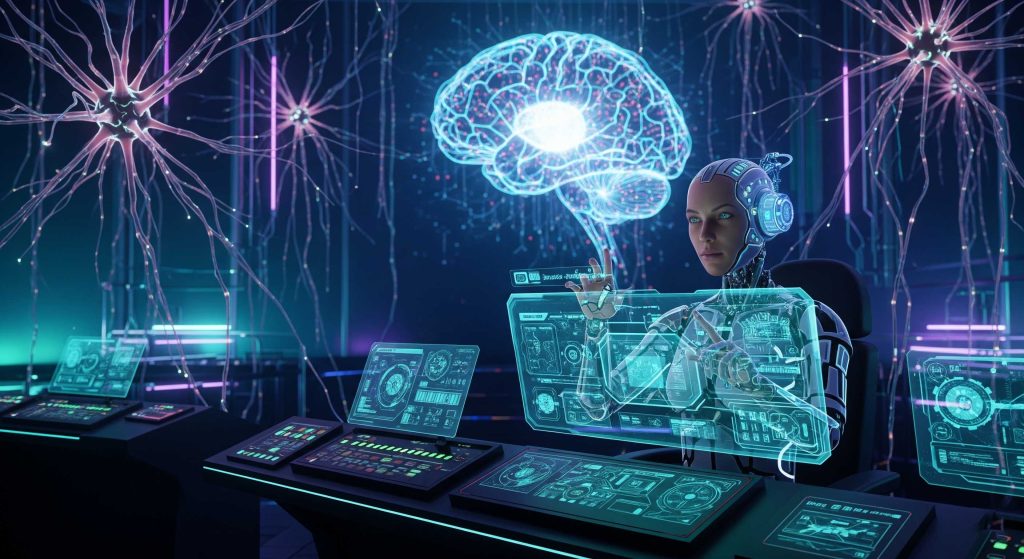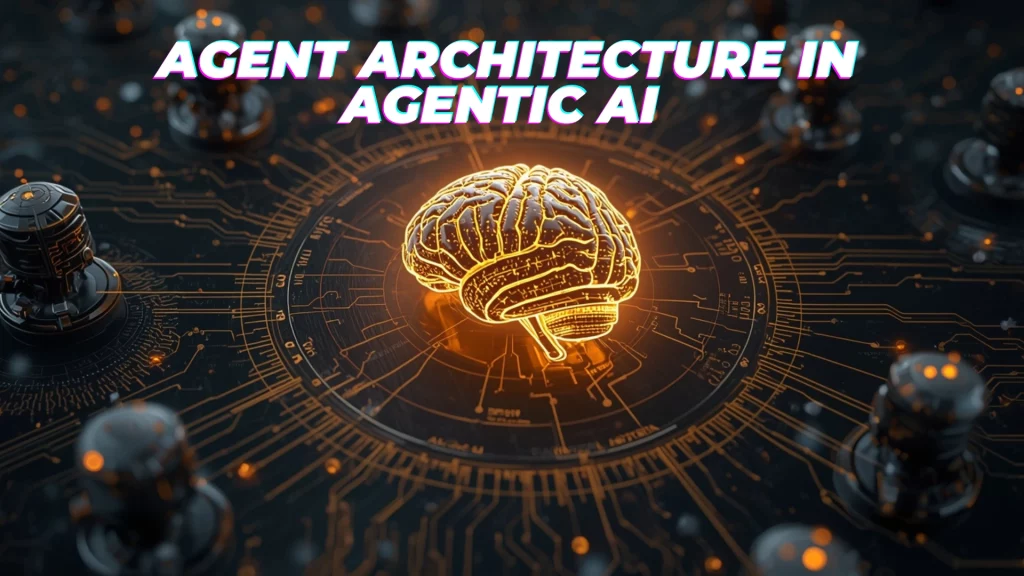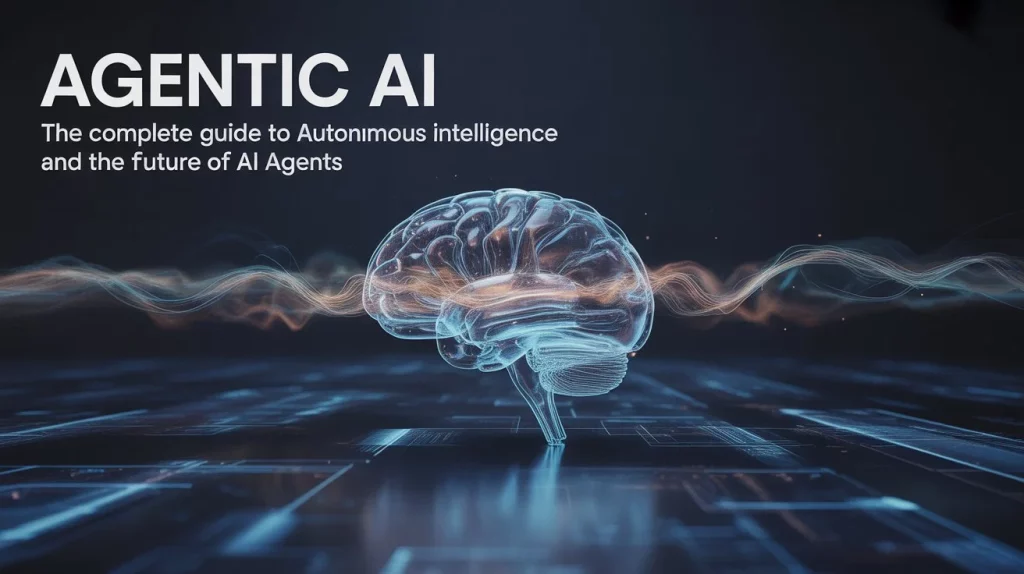Beyond Reactive AI – The Rise of Autonomous Agents
In the rapidly evolving landscape of Artificial Intelligence, a new paradigm is taking center stage: Agentic AI. Unlike traditional AI systems that primarily react to specific inputs or perform narrow tasks, Agentic AI systems are designed to act autonomously, plan, make decisions, and execute complex goals with minimal human intervention. This shift from reactive to proactive AI represents a significant leap forward, promising to revolutionize everything from software development to complex business operations.
For developers, researchers, and tech enthusiasts, understanding the inner workings of Agentic AI is crucial. What are the fundamental components that enable these systems to think and act independently? How do they facilitate autonomous decision-making, especially in intricate domains like code generation? And what are the significant challenges that must be overcome to fully realize their potential?
This blog post will provide a deep dive into Agentic AI, dissecting its key architectural components, explaining the sophisticated process behind its autonomous decision-making, and candidly addressing the formidable challenges in its implementation. By the end, you’ll have a comprehensive technical understanding of this transformative AI frontier.
What is Agentic AI and How Does It Differ from Traditional AI?
Before we delve into the components, let’s clarify what Agentic AI is and how it stands apart from the AI systems we’ve grown accustomed to.
Agentic AI refers to artificial intelligence systems capable of acting autonomously on behalf of users to accomplish specific goals. They are not just predictive models they are intelligent agents that can perceive their environment, reason about it, formulate plans, and execute actions to achieve their objectives.
Key Differentiating Factors from Traditional AI:
- Autonomy: Traditional AI often requires constant human guidance or operates within highly constrained environments. Agentic AI, conversely, can operate independently, interpreting user intent and executing tasks without continuous oversight.
- Goal-Oriented Behavior: While many AI systems perform classification or prediction, Agentic AI is designed to pursue specific, often multi-step, objectives. They can break down complex goals into manageable sub-tasks and work through them systematically.
- Environmental Interaction: Agentic AI systems actively interact with their environment, which can include an Integrated Development Environment (IDE), operating systems, web services, or other digital tools. They can use these tools, access resources, and modify their environment as needed to achieve their goals.
- Adaptability: These systems can adjust their strategies based on feedback and changing circumstances. They learn from successes and failures, continuously improving their performance over time.
- Reasoning Capabilities: Agentic AI incorporates sophisticated reasoning mechanisms that allow them to understand context, make inferences, and handle uncertainty, moving beyond simple pattern matching to more human-like cognitive processes.
In the context of code generation, for example, a traditional AI might suggest a code snippet. An Agentic AI, however, could understand the developer’s overall intent, gather relevant documentation, plan the entire implementation, generate the code, explain its reasoning, and even adapt to the developer’s coding style and feedback.
Key Components of an Agentic AI System
An Agentic AI system is a complex orchestration of several interconnected modules, each playing a crucial role in enabling autonomous, goal-directed behavior. While implementations can vary, a typical Agentic AI architecture includes:
1. Foundation Model (The Brain)
At the core of most modern Agentic AI systems is a powerful Large Language Model (LLM) or another type of foundation model. This component provides the foundational capabilities for understanding and generating natural language and code. It supplies the system with general knowledge, reasoning abilities, and the capacity to process and synthesize information from diverse sources. The quality and capabilities of the foundation model significantly influence the overall intelligence and versatility of the agent.
2. Planning Module (The Strategist)
This module is responsible for breaking down complex, high-level tasks into a sequence of smaller, executable steps. It formulates plans, anticipates potential obstacles, and determines the most efficient path to achieving a given goal. For code generation, this might involve planning the structure of classes, functions, and their interactions before writing any actual code. Advanced planning modules can even generate alternative plans and evaluate their feasibility.
3. Memory System (The Historian and Knowledge Base)
Agentic AI requires robust memory capabilities to maintain context and learn over time. This typically involves:
- Short-term Working Memory: To maintain context during an ongoing task or conversation, allowing the agent to remember recent interactions and relevant information.
- Long-term Memory: To store knowledge, past experiences, user preferences, and learned strategies. This can include episodic memory (recording specific interactions), semantic memory (storing factual knowledge), and procedural memory (remembering how to perform tasks or use tools).
4. Tool Use Framework (The Handyman)
This component is critical for enabling the AI to interact with the external world. It allows the agent to call external functions, access APIs, query databases, use web services, or interact with an operating system or IDE. In a code generation context, this might include searching documentation, accessing version control systems, running tests, or manipulating files. The ability to use tools extends the agent’s capabilities far beyond its inherent model knowledge.
5. Retrieval System (The Librarian)
Often implemented as a Retrieval-Augmented Generation (RAG) system, this component allows the AI to access and incorporate external knowledge sources that were not part of its initial training data. This includes up-to-date documentation, code repositories, user-specific resources, or real-time information from the web. By retrieving relevant information, the agent can provide more accurate, contextually relevant, and up-to-date responses.
6. Reasoning Engine (The Logician)
This module enables the AI to make inferences, evaluate options, and make decisions, especially under uncertainty. It incorporates various reasoning techniques, such as chain-of-thought reasoning (breaking down problems into logical steps), tree-of-thought exploration (exploring multiple reasoning paths), or other structured approaches to arrive at robust conclusions.
7. Feedback Processing (The Learner)
This component allows the system to learn and adapt from user feedback, both explicit (direct corrections, instructions, or preferences) and implicit (observing which suggestions are accepted or rejected, or how users interact with its outputs). This continuous learning loop is vital for improving the agent’s performance and aligning it with user expectations.
8. Self-monitoring and Reflection (The Self-Aware Observer)
Advanced Agentic AI systems include mechanisms to monitor their own performance, detect errors or limitations, and reflect on their actions. This allows them to identify when a plan is failing, when more information is needed, or when their approach needs adjustment. This meta-cognition is a hallmark of sophisticated autonomous systems.
9. Communication Interface (The Communicator)
This component handles how the AI presents information to users, including explanations of its reasoning, suggestions, and requests for clarification. A clear and intuitive communication interface is essential for building user trust and facilitating effective collaboration between human and AI.
10. Safety and Alignment Mechanisms (The Guardian)
Crucially, these components ensure that the AI’s actions align with user intent and ethical considerations. They are designed to prevent harmful, biased, or undesired behaviors, ensuring the agent operates within defined safety boundaries.
Autonomous Decision-Making in Code Generation: A Detailed Look
Agentic AI’s ability to make autonomous decisions is particularly transformative in code generation. This process is far more sophisticated than simple autocomplete, involving a multi-stage cognitive loop:
- Context Understanding: The agent first analyzes the entire development context: the existing codebase, project structure, relevant files, dependencies, and the specific task the developer is trying to achieve. It builds a comprehensive mental model of the problem space.
- Knowledge Retrieval: Based on this understanding, the Agentic AI retrieves relevant information from its knowledge bases. This might involve querying internal documentation, external API references, best practice guides, or similar code examples from vast repositories. Retrieval-Augmented Generation (RAG) plays a key role here.
- Problem Decomposition: Complex coding tasks are broken down into smaller, manageable sub-problems. For instance, implementing a new feature might be decomposed into defining data models, creating API endpoints, implementing business logic, and integrating with the UI.
- Solution Planning: The system then develops a detailed plan for implementing the solution. This plan considers factors like code organization, design patterns, performance implications, error handling, and compatibility with the existing codebase. It acts as a strategic roadmap.
- Alternative Evaluation: For critical decisions (e.g., choosing a library, selecting an algorithm, or applying a design pattern), the Agentic AI can evaluate multiple alternatives. It weighs trade-offs based on criteria such as performance, maintainability, security, and alignment with project standards.
- Code Generation with Reasoning: As the agent generates code, it maintains an internal reasoning process. It can justify each decision made, explaining why certain patterns were chosen, how edge cases are handled, or how the implementation aligns with best practices. This internal monologue is crucial for exploitability.
- Self-Review and Refinement: After generating initial code, the agent reviews its own output. It can identify potential issues like logical errors, performance bottlenecks, security vulnerabilities, or deviations from coding standards. It then iteratively refines the code to address these concerns, often running internal tests or simulations.
- Explanation Generation: The agent can then articulate its decision-making process to the developer, providing clear rationales for its implementation choices and highlighting important considerations or trade-offs.
- Adaptation to Feedback: When the developer provides feedback, makes manual changes, or accepts/rejects suggestions, the agent learns from these interactions. This feedback loop allows it to adjust its understanding of the developer’s preferences, coding style, and project requirements, leading to increasingly personalized and effective assistance.
- Continuous Learning: Over time, by observing which solutions are accepted and which are rejected, the agent continuously refines its internal models and decision-making heuristics, building a more effective and reliable code generation capability.
This sophisticated process allows Agentic AI to generate code that is not only syntactically correct but also well-structured, efficient, secure, and deeply aligned with the developer’s intent and project standards.
Challenges in Implementing Agentic AI for Code Assistance
While the potential of Agentic AI in code assistance is immense, its implementation comes with several significant challenges that researchers and engineers are actively working to address:
- Context Window Limitations: Even with expanded context windows, current LLMs have finite limits on how much code and documentation they can process simultaneously. This is a major hurdle for large, complex codebases where understanding the full project context is vital for generating appropriate and consistent code.
- Maintaining Project-Wide Consistency: Generating new code that seamlessly integrates and maintains consistency with existing patterns, naming conventions, and architectural decisions across an entire project requires a deep, holistic understanding of the codebase, which is difficult for current models to achieve consistently.
- Handling Ambiguity in Requirements: Developer requests are often ambiguous, incomplete, or evolve during the development process. Agentic AI systems must be able to identify when clarification is needed, ask intelligent follow-up questions, and adapt to changing requirements.
- Balancing Autonomy and Control: Finding the right equilibrium between autonomous action and developer control is a delicate balance. Too much autonomy can lead to unexpected or unwanted changes, while too little defeats the purpose of an agentic system. Developers need to feel in control while benefiting from automation.
- Ensuring Code Quality and Security: Generated code must adhere to high standards of quality, performance, and security. This requires the AI to have up-to-date knowledge of best practices, common vulnerabilities, and secure coding principles across multiple languages and frameworks.
- Explaining Complex Decisions: Providing clear, concise, and accurate explanations for complex implementation decisions made by the AI is challenging but essential for building developer trust, enabling effective collaboration, and debugging.
- Handling Rapidly Evolving Technologies: The software development ecosystem is constantly changing, with new languages, frameworks, and libraries emerging frequently. Keeping the AI’s knowledge current and ensuring its ability to work with the latest technologies requires continuous updates and robust learning mechanisms.
- Integration with Development Workflows: Seamlessly integrating Agentic AI into diverse development environments (IDEs), version control systems (Git), and testing frameworks requires flexible and robust integration capabilities.
- Performance Constraints: Code assistance must be responsive to maintain developer flow. Balancing the depth of analysis and reasoning with the need for quick response times is a significant challenge, especially for complex codebases.
- Personalization: Developers have different preferences, skill levels, and coding styles. Adapting to individual developers while still promoting best practices and consistency across a team requires sophisticated personalization mechanisms.
- Handling Partial or Incorrect Code: Developers frequently work with incomplete or temporarily incorrect code. The AI must be robust enough to provide useful assistance and avoid breaking existing code even in these messy, real-world scenarios.
- Privacy and Intellectual Property Concerns: Processing potentially sensitive or proprietary code raises significant privacy and intellectual property concerns. Secure handling of code and data, along with clear policies on data usage, are paramount.
- Evaluation and Metrics: Defining appropriate metrics for evaluating the effectiveness of Agentic AI in code assistance is challenging. Traditional metrics like perplexity or BLEU scores don’t fully capture improvements in developer productivity, code quality, or innovation.
- Computational Resource Requirements: Sophisticated Agentic AI systems, especially those with large foundation models and complex reasoning capabilities, require significant computational resources, which can be costly and may limit accessibility for smaller teams or individual developers.
- Ethical Considerations: Beyond technical challenges, ethical issues like potential job displacement, over-reliance on AI-generated code, and the perpetuation of biases present complex societal questions that need thoughtful consideration and proactive solutions.
Addressing these challenges requires a concerted effort from AI researchers, developers, and the broader tech community, combining technical innovation with careful system design and ethical foresight.
Conclusion: The Future of Development is Agentic
Agentic AI represents a profound evolution in how we interact with and leverage artificial intelligence, particularly in the domain of software development. By understanding its core components, the intricacies of its autonomous decision-making, and the challenges that lie ahead, we can better prepare for and shape this transformative future.
While significant hurdles remain, the promise of Agentic AI to enhance developer productivity, automate complex tasks, and accelerate innovation is undeniable. As these systems become more sophisticated and integrated, they will undoubtedly redefine the developer experience, allowing human creativity and problem-solving to reach new heights.
The journey of Agentic AI is just beginning, and its impact on the world of code is set to be revolutionary. Stay tuned as we continue to explore its practical applications and ethical implications.









